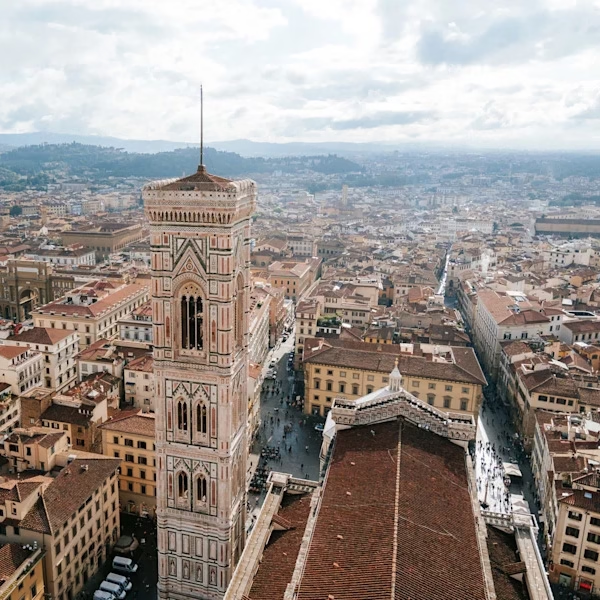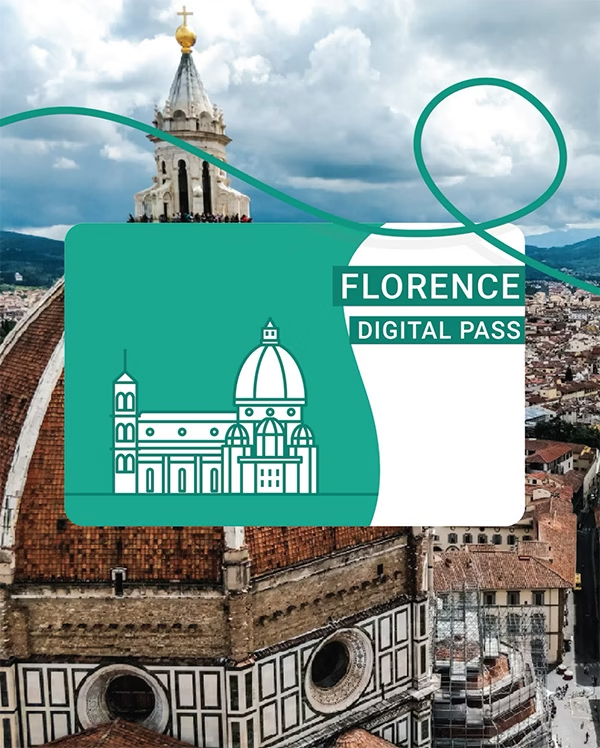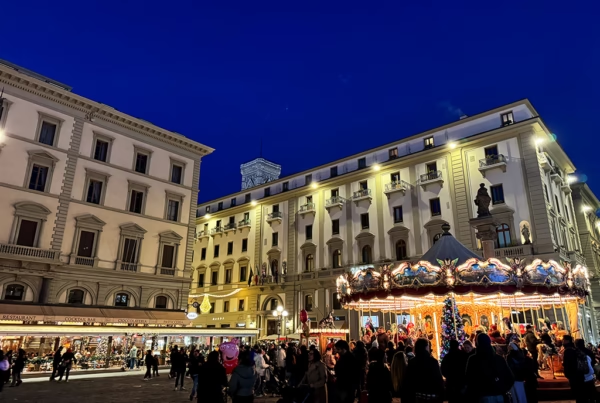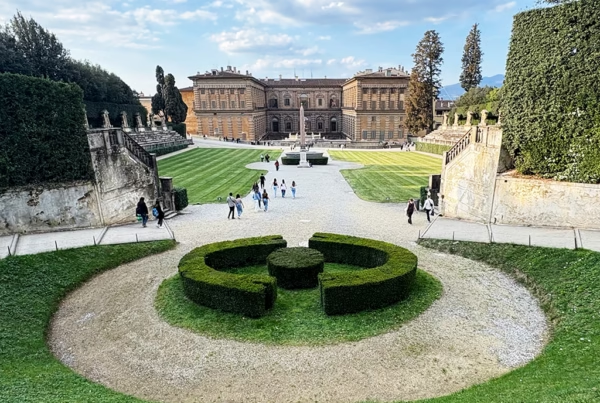Step into a storybook of history in the center of Florence: Piazza della Signoria. This beautiful square encapsulates Florence’s essence like no other, with beautiful sculptures and is home to the iconic Palazzo Vecchio.
Located in the heart of the city, Piazza della Signoria is a place you do not want to miss.

Piazza della Signoria is unmissable when you visit Florence
Everything You Need to Know About Piazza Della Signoria Florence
The magic of Florence, in one spot. As soon as you step onto Piazza della Signoria, you will be struck by the evocative combination of art and the city.

There is so much to see in Piazza della Signoria, so make sure you give yourself plenty of time to explore
It’s a true artistic showcase and the ultimate gathering spot for Florentines and tourists alike.
On this page, I’ll be delving into:
The Long History of Piazza Della Signoria Florence

Always a hub of activity even at night, the piazza has long been a focal point for daily life in Florence
Ancient Roman origins
The site of the Piazza della Signoria has been a public gathering space since ancient Roman times.
Archaeological remains found under the piazza reveal that it was the site of an ancient Roman forum used for public meetings, trading, and rituals with a theatre, baths and a workshop where fabrics were dyed. When Florence was founded in the 1st century CE, this square was already at the heart of it.
Medieval construction
The unusual shape of the square comes from the intense rivalry between the Ghibelines and Guelphs in the thirteenth century. The victorious Guelphs demolished the houses of their rivals and vouched never to rebuild as they believed the place was damned.
With the erection of Palazzo Vecchio, a new chapter began.

The imposing palace has been an important place in Florence for hundreds of years
Originally called the Palazzo della Signoria, this impressive palace would show the importance of the city of Florence and the l-shaped piazza would become the civic center of the city.
Palazzo Vecchio with its tall tower was constructed to house the city’s governors and became the focal point of the space, as well as a distinctive feature on the skyline of Florence.
Piazza della Signoria as we know it today
Over the following centuries, Piazza della Signoria remained at the heart of Florence’s civic activity, being the stage for festivals and rallies.
Piazza della Signoria’s history was particularly influenced by the influential de’ Medici family. The Medici, patrons of the arts, took over Palazzo Vecchio as their palace and helped turn the piazza outside into something truly special. Statues and art proclaiming Florence’s wealth and power were added, included the Neptune Fountain, the outdoor gallery of the Loggia dei Lanzi, and of course, a huge statue of Cosimo I.

Cosimo I de’Medici understood the power of symbols, with this huge depiction of him on his horse demonstrating his influence to everyone who sees it
In 1494, conspiracies against the Medici family led to their exile and Dominican friar Girolamo Savonarola stepped into the vacuum.
Savonarola criticized Renaissance excesses, leading to the “Bonfire of the Vanities” in the square when art, books, rich furniture and clothing was burned in a huge pyre, sometimes voluntarily, sometimes forced. His rule was violent but brief, and he was executed in 1498.

This plaque in the piazza commemorates the spot where Savonarola was executed
When the de’ Medici family returned to power in 1530, they ordered renovations to the buildings surrounding the public square to reassert their authority. They commissioned statues and fountains to decorate the piazza, demonstrating their wealth and influence.
The Loggia dei Lanzi was installed to showcase sculptures including Cellini’s famous bronze Perseus. Today, the Piazza della Signoria is an open-air sculpture gallery, with a copy of Michelangelo’s David statue standing in the place where the original statue was first installed in 1504.

I have always loved the Loggia dei Lanzi, one of the earliest examples of public art
An exclusive experience at the Duomo awaits ✨
Join this exclusive tour and explore one of Italy’s most iconic churches, Florence’s Duomo. Enter after closing time for a VIP, crowd-free experience, including climbing up inside the famous dome and going outside onto the cathedral terraces! Click here to secure your spot today!
What Buildings are on Piazza della Signoria
The Piazza della Signoria is bordered by iconic buildings like the medieval Palazzo Vecchio, the Renaissance Palazzo Uguccioni and Tribunale della Mercanzia, and the modern Palazzo delle Assicurazioni Generali.

The Palazzo Vecchio is just one of the fascinating buildings on Signoria square
Palazzo Vecchio and Arnolfo Tower
The Palazzo Vecchio is one of the most important medieval buildings in Italy. Construction of the town hall began in 1299 (originally called Palazzo della Signoria) but continued over several centuries.
While Arnolfo di Cambio is credited with the early designs, the building underwent modifications by subsequent architects, including Francesco Talenti and Giorgio Vasari. Palazzo Vecchio was designed to be the home of civic life in Florence, but it has served various functions over the years, including as a residence for the ruling Medici family.

The courtyard is free to enter so even if you don’t have time to explore the whole museum, you can still see this part of the old building
Originally built as the town hall, and still used as such today, it now also houses a museum with an amazing collection of art spanning the 13-19th centuries.
Highlights include the palace rooms with frescoes and other historical works, the Salone dei Cinquecento with epic 16th-century frescoes by Vasari, and the Map Room, with its collection of maps from the mid 1500’s.

The Map Room in Palazzo Vecchio is a fascinating insight into the world as it was known in the 1500’s
The building’s most iconic feature is the 308-foot-tall Arnolfo Tower, a landmark on the Florentine skyline. The tower offers incredible views from the top.
An interesting fact about the tower is that it houses the prison cell where both Grand Duke Cosimo Medici and Girolamo Savonarola were locked up.

The views from the Arnolfo tower are spectacular
The tower is part of the complex of the Palazzo Vecchio, but you can also buy a ticket just to climb the tower.
Palazzo della Mercanzia
On the southern side of Piazza della Signoria stands the imposing former Tribunale della Mercanzia. Built in the late 13th century, this palace housed Florence’s commercial court.
The coats of arms still visible on the facade represent the different merchant and artisan guilds whose disputes were settled here. The magistrates revered Saint Thomas as their patron saint for his perceived impartiality.
After the court moved in the 17th century, the building fell into disrepair.

Now the Gucci Museum, the palazzo has been renovated to its former glory
Today, the restored Palazzo della Mercanzia serves as the home of the Gucci Museum, allowing visitors an interesting view into the history of this iconic Italian fashion house.
Palazzo Uguccioni
The early 16th-century Palazzo Uguccioni adds a captivating contrast to the piazza. Named after its original owner, this small yet striking palace features the classical style of High Renaissance architects like Raphael and Bramante.
The decorative columns and ornamental window frames on its facade lend a verticality that contrasts beautifully with the strong horizontals of the neighboring Palazzo Vecchio. Though relatively little is known about the origins of the palace, its elegant design has made it a distinctive part of the Piazza della Signoria ensemble for over five centuries.
Its harmonious interplay with the Gothic, Romanesque, and Baroque elements surrounding it encapsulates the rich architectural layers that make Florence such an enchanting city.

Palazzo Uguccioni is easy to overlook thanks to the restaurants and cafes that surround it, but take a moment to look up at the building facade
Palazzo delle Assicurazioni Generali
The Palazzo delle Assicurazioni Generali is a neo-Renaissance-style building constructed in the late 19th century for the noble Fenzi banking family.
It stands on the former site of the Loggia of the Pisani and Santa Cecilia church. Designed by architect Emilio Sala, its ornate facade featuring both Classical and Gothic elements is typical of the Eclectic style popular in 19th-century Florence.
Today the ground floor of this palace is home to numerous shops, including the historical Rivoire Café, a dainty and elegant chocolatier-pastry shop, offering handmade chocolate as well as gourmet treats, including their delectable pralines and cantucci biscuits.

The Rivoire Café is a must-stop for a coffee and sweet treat
Organize your transport easily and stress-free for any trip to Florence and Tuscany:
What There is to See in Piazza della Signoria Florence
The Piazza della Signoria is not just defined by the buildings surrounding it, but is a true open-air museum with the famous Loggia dei Lanzi housing just part of the impressive sculpture collection on this square.
Loggia dei Lanzi
Undoubtedly the utmost distinctive architectural feature of the square, the Loggia dei Lanzi is an open-air sculpture gallery. It is a wide, covered loggia (gallery) that was built in the 14th century. First constructed under the early Florentine Republic, the arched loggia initially hosted public councils and ceremonial gatherings.
In the 16th century during the rule of Cosimo I de’ Medici, the Loggia dei Lanzi was transformed into an open-air sculpture gallery. The Loggia, which was until then called the Loggia della Signoria, was renamed after the so-called lanzi: the lancers who were bodyguards of Cosimo I de’ Medici.

I love the lion guarding the steps of the Loggia dei Lanzi
The Loggia dei Lanzi is renowned for housing a collection of impressive sculptures, including several masterpieces of Renaissance art.
Some famous sculptures on display include Giambologna’s “Rape of the Sabine Women,” and “Hercules Beating the Centaur Nessus”, Benvenuto Cellini’s “Perseus with the Head of Medusa,” and various other classical and mythological figures.

Perseus with the head of Medusa is just one of the incredible pieces of art on display here
Adorning the front of the Loggia, just beneath the railing, you’ll find trefoils featuring symbolic representations of the four cardinal virtues (Fortitude, Temperance, Justice, and Prudence) skilfully crafted by Agnolo Gaddi.
Flanking the entrance are two marble lion statues, one an ancient Roman original and the other sculpted by Flaminio Vacca (1538-1605). A symbol of power, justice and honor, the use of sculpted lions as guards of a building dates back to the dawn of civilization.
The loggia’s open design allows visitors to appreciate these sculptures in an outdoor setting, adding to the charm and cultural richness of the Piazza della Signoria.
The Fountain of Neptune
The Neptune Fountain in Piazza della Signoria stands as a majestic symbol of artistic mastery.
Located near the northwest corner of Palazzo Vecchio, the fountain is one of the most photographed spots in Florence.
Sculpted by Bartolomeo Ammannati in the 16th century, this impressive fountain portrays the sea god Neptune in all his might with the signs of the zodiac engraved below his chariot, surrounded by mythical creatures and nymphs.
The intricate details and powerful stance of Neptune create a captivating focal point. As water gracefully flows from the sculptures, the fountain exudes a sense of timeless elegance.
This artistic masterpiece, situated in the heart of Florence, invites visitors to admire its craftsmanship and immerse themselves in the allure of Renaissance sculpture.

When the sun is shining the fountain is almost blindingly white
The Neptune fountain is also known as il biancone, nicknamed for the high-quality Carrara marble sculptor Bartolomeo Ammannati selected. The white of the marble was so intense, that the very first time it was shown in public, the statue seemed to be glowing.
Savonarola Plaque
In between the fountain of Neptune and the equestrian statue of Cosimo de’ Medici, a discreet yet significant round marble plaque marks the spot where Girolamo Savonarola, the Dominican friar and reformer, was hanged and burned in 1498.

Look out for this plaque which commemorates the burning of Savanorola
A poignant reminder of historical events in Florence, the plaque remembers the turbulent times of the Bonfire of the Vanities. The inscription on the plaque commemorates the historical significance of this location, inviting contemplation on the intersection of politics and religious fervor in Renaissance Florence.
Statues
Next to the fountain, the Marzocco, a lion representing the city’s grandeur, rules over the square.
The lion is named after the Latin term “Marticus” associated with Mars, the God of War. Donatello, a renowned sculptor, selected the lion as a symbol for the Republic of Florence, adorning its feet with the Lily (Giglio), the city’s coat of arms.

The lion can be overlooked next to Neptune, but the symbolism on display is equally as important to the history of Florence
Notably, this statue holds the distinction of being the first secular public sculpture commissioned, with the original now safeguarded in the Bargello Museum.
Another prominent piece, the bronze sculpture “Judith and Holofernes” by Donatello, is replicated in front of Palazzo Vecchio, while the original resides within the museum.
Overlooking the square, an equestrian statue by Jean de Boulogne pays homage to Cosimo I De Medici, the first Grand Duke of Tuscany.

Set slightly away from Palazzo Vecchio, the large equestrian statue looks like the horse is about to gallop away
Lastly, flanking the main entrance to the Palazzo Vecchio Museum, are two impressive marble statues: a copy of Michelangelo’s David (the original found in the Galleria dell’Accademia) and the Hercules of Baccio Bandinelli, a devoted follower of Michelangelo.

The original David once stood here, but was replaced with this copy when it was moved to the Accademia Gallery to preserve it
Discover Florence easily with this pass!
Access the Uffizi Gallery, Accademia Gallery, and Brunelleschi’s Dome, all with one ticket by getting yourself this unique Florence digital visit card. Save money and make visiting the top sites stress-free – click here to find out more:
How to Visit Piazza della Signoria
Piazza della Signoria is located in the heart of Florence, between Piazza della Repubblica and the Uffizi Gallery. It’s a short walk from landmarks such as the Ponte Vecchio and Florence Cathedral.
The best part? It’s free and open all the time.
Although easily reached by foot, several lines of public transportation connect to the square: nearby stops are Condotta and Galleria degli Uffizi.
Be sure to Pin this guide if you enjoyed it or found it useful!
Save this page by pinning it and be sure to follow us on Pinterest for more travel inspiration and guides:

To sum up…
You cannot avoid seeing Piazza della Signoria at least once during your trip to Florence. Rather than rushing through it on your way to the Uffizi or across to the Basilica of Santa Croce. make sure to take some time to admire the impressive sculptures and historical references.
For lots more Florence travel tips, tricks and recommendations, be sure to subscribe to our 100% free Florencewise newsletter. Subscribers also get exclusive discounts and perks from our friends and partners helping saving you money on your trip here!
Florencewise’s Top Travel Resources
Ready to book your trip to Florence? Take a look at these helpful links to friends and partners we use ourselves and trust:
🚕 Organise your airport transfer for a stress-free arrival
🛏️ Search for and book your perfect accommodation
🧳 Our complete guide to what to pack for Florence
⭐️ The number one travel accessory, a multi-point travel adapter and voltage converter
🏛️ Browse a huge range of tours in Florence, Tuscany and beyond
👌 Experience unique tours and special access to Florence’s most popular sights
💪 Protect yourself with comprehensive travel insurance
📱 Stay connected without incurring large fees with a reliable eSim
🚂 Plan your train journeys and purchase tickets all in one place









